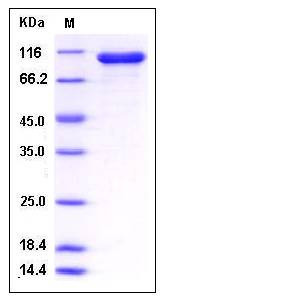Human STAT1 / p91 Protein (His & GST Tag)
CANDF7,IMD31A,IMD31B,IMD31C,ISGF-3,STAT91
- 100ug (NPP4290) Please inquiry
| Catalog Number | P12766-H20B |
|---|---|
| Organism Species | Human |
| Host | Baculovirus-Insect Cells |
| Synonyms | CANDF7,IMD31A,IMD31B,IMD31C,ISGF-3,STAT91 |
| Molecular Weight | The recombinant human STAT1/GST chimera consists of 950 amino acids and has a calculated molecular mass of 111 kDa. It migrates as an approximately 105 kDa band in SDS-PAGE under reducing conditions. |
| predicted N | Met |
| SDS-PAGE |  |
| Purity | > 92 % as determined by SDS-PAGE |
| Protein Construction | A DNA sequence encoding the human STAT1 isoform beta (P42224-2) (Met 1-Val 712) was fused with the N-terminal polyhistidine-tagged GST tag at the N-terminus. |
| Bio-activity | |
| Research Area | Cancer |Signal transduction |Transcription Factors and Regulators |Immunoglobulin-Like Domain Transcription Factors |
| Formulation | Lyophilized from sterile 20mM Tris, 500mM NaCl, pH 7.4 1. Normally 5 % - 8 % trehalose and mannitol are added as protectants before lyophilization. Specific concentrations are included in the hardcopy of COA. |
| Background | STAT1 is a member of the STAT protein family. In response to cytokines and growth factors, STAT family members are phosphorylated by the receptor associated kinases, and then form homo- or heterodimers that translocate to the cell nucleus where they act as transcription activators. STAT1 can be activated by various ligands, including interferon-alpha, interferon-gamma, EGF, PDGF and IL6. It is a signal transducer and transcription activator that mediates cellular responses to interferons (IFNs), cytokine KITLG/SCF and other cytokines and growth factors. The phosphorylated STATs dimerize, associate with ISGF3G/IRF-9 to form a complex termed ISGF3 transcription factor, that enters the nucleus. ISGF3 binds to the IFN stimulated response element (ISRE) to activate the transcription of interferon stimulated genes, which drive the cell in an antiviral state. In response to type II IFN (IFN-gamma), STAT1 is tyrosine- and serine-phosphorylated. It then forms a homodimer termed IFN-gamma-activated factor (GAF), migrates into the nucleus and binds to the IFN gamma activated sequence (GAS) to drive the expression of the target genes, inducing a cellular antiviral state. STAT1 becomes activated in response to KITLG/SCF and KIT signaling and may mediate cellular responses to activated FGFR1, FGFR2, FGFR3 and FGFR4. Defects in STAT1 can cause STAT1 deficiency complete and familial candidiasis type 7. |
| Reference |
